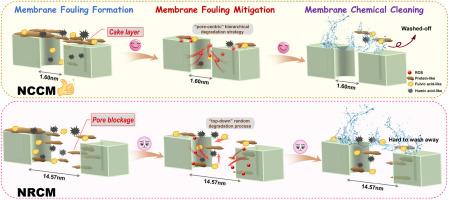Nanoconfined catalytic membranes for EfOM fouling mitigation: An intelligent “pore-centric” cleaning strategy
IF 8.4
1区 工程技术
Q1 ENGINEERING, CHEMICAL
引用次数: 0
Abstract
This study investigated the effectiveness of the nanoconfined catalytic membrane (NCCM), fabricated by nitrogen-doped carbon nanotubes (NCNT) incorporated with graphene oxide membrane (NCNT@GO-M), in mitigating fouling caused by effluent organic matter (EfOM). Compared to conventional catalytic membranes (NRCM) that lack precise spatial design and prepared with only NCNT, NCCM exhibits a unique advantage by preferentially retaining and adsorbing protein-like substances in EfOM during the fouling formation process, forming a cake layer that effectively mitigates pore blockage from irreversible foulants. Furthermore, the ordered nanoconfined structure of NCCM facilitates an intelligent “pore-centric” hierarchical degradation strategy based on the molecular size of EfOM, preferentially removing irreversible foulants caused by fulvic acid-like and low molecular weight protein-like substances. The results demonstrated effective preservation of catalytic sites by the NCCM’s advanced nanoconfined configuration and a 1.6-fold increase in the mass transfer rate of peroxymonosulfate (PMS) compared to NRCM, synergistically promoting hydroxyl radical (•OH) enrichment, resulting in rapid EfOM degradation kinetics. Additionally, chemical cleaning almost completely eliminated irreversible fouling, restoring the NCCM to near its original flux. Overall, this study sheds light on the fouling mitigation mechanisms of NCCM, aiding their tailored design and application in targeted wastewater treatment.

用于减轻 EfOM 污垢的纳米催化膜:以孔隙为中心 "的智能清洁策略
本研究探讨了由掺氮碳纳米管(NCNT)与氧化石墨烯膜(NCNT@GO-M)结合制成的纳米约束催化膜(NCCM)在减轻污水有机物(EfOM)造成的污垢方面的效果。与缺乏精确空间设计、仅使用 NCNT 制备的传统催化膜(NRCM)相比,NCCM 在污垢形成过程中优先截留和吸附 EfOM 中的蛋白质类物质,形成滤饼层,有效缓解不可逆污垢物造成的孔隙堵塞,从而展现出独特的优势。此外,NCCM 的有序纳米封闭结构有助于根据 EfOM 的分子大小,采用 "以孔为中心 "的智能分层降解策略,优先去除由类富勒酸和低分子量类蛋白物质引起的不可逆污垢。结果表明,与 NRCM 相比,NCCM 先进的纳米封闭结构有效地保留了催化位点,过一硫酸盐 (PMS) 的传质速率提高了 1.6 倍,协同促进了羟基自由基 (-OH) 的富集,从而实现了 EfOM 的快速降解动力学。此外,化学清洗几乎完全消除了不可逆转的污垢,使 NCCM 恢复到接近其原始通量的状态。总之,这项研究揭示了 NCCM 的污垢缓解机制,有助于其在定向废水处理中的定制设计和应用。
本文章由计算机程序翻译,如有差异,请以英文原文为准。
求助全文
约1分钟内获得全文
求助全文
来源期刊

Journal of Membrane Science
工程技术-高分子科学
CiteScore
17.10
自引率
17.90%
发文量
1031
审稿时长
2.5 months
期刊介绍:
The Journal of Membrane Science is a publication that focuses on membrane systems and is aimed at academic and industrial chemists, chemical engineers, materials scientists, and membranologists. It publishes original research and reviews on various aspects of membrane transport, membrane formation/structure, fouling, module/process design, and processes/applications. The journal primarily focuses on the structure, function, and performance of non-biological membranes but also includes papers that relate to biological membranes. The Journal of Membrane Science publishes Full Text Papers, State-of-the-Art Reviews, Letters to the Editor, and Perspectives.
 求助内容:
求助内容: 应助结果提醒方式:
应助结果提醒方式:


